
After designing gardens for over 20 years, I’ve noticed more and more people want to replace their little-used front lawn with an environmentally friendly garden.
The main stumbling block, however, is they aren’t quite sure what to do once the lawn is gone.
I hear variations of the same concerns: it’ll look too much like a desert, it won’t be lush, it’ll be too sparse or it won’t have enough color.
Therefore, I thought it might be helpful if I show a few before and after photos of a new garden’s progress in the hopes it inspires you to re-think your front lawn!
Oh, how I wish I had the ‘Before-when-I-first-drove-up’ picture! You would’ve seen a very typical straight cement pathway (complete with cracks) leading from the sidewalk to the front door. While the lawn wasn’t huge, it also wasn’t used – EVER.
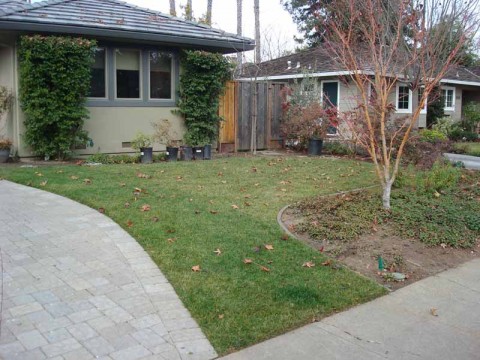

Well, that’s not entirely true. The only time the lawn was used was when walking to the gate on the side of the house.
So, after removing the lawn we installed a functional side path that would provide a much nicer experience as you strolled through the garden.
The main path also approaches the front door from the driveway, which is not only functional but also divides the front garden into three distinct spaces.
More views of the side pathway, interplanted with ‘Elfin’ thyme (which lies very flat to the ground and doesn’t bunch up like many of the other thymes do.)
One of the main challenges of this garden was a HUGE tree in the center planting area.
The tree’s roots made it almost impossible to plant anything deeper than a few inches, as well as the roots stealing much needed water and nutrients from the nearby plants. As a result, nothing ever thrived in this area. Until we raised the soil level, that is.
To raise the soil level just a bit (12-14″) one of my favorite methods is to install half-circles of stone.
I’m not a fan of planting beds that have their borders lined with river rocks, as they tend to look a little contrived. Instead, I prefer creating half-circle shapes that are created inside the bed – a few feet from the edge of the planting area.
To give the stones a more natural look, bury them by 1/3. That way, they’ll look like they’ve been there for a long time versus just plopped down on the ground. The stone half-circle will allow the addition of several inches of soil for new plants (as well as adding height and interest to an otherwise flat space.)
Here’s a tip: Place a plant near the end of the half-circle to blur the beginning and end points. This results in a more natural look, letting the stones appear and disappear within the planting bed.
And now for the close-ups!

When using a lot of gold and chartreuse in the garden remember to temper the brightness by including plenty of complementary colors, such as lavender and blue.
These colors visually ‘cool down’ the hot tones, providing much needed contrast and interest.
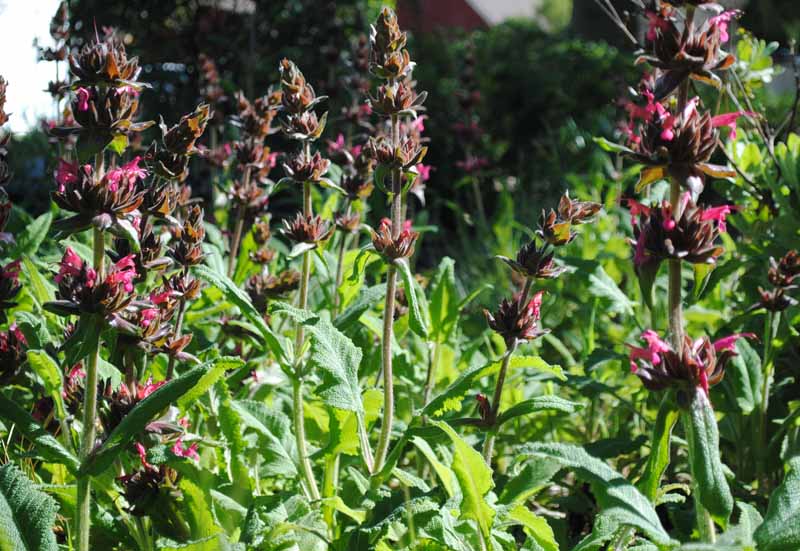
California’s native salvia spatheca (Hummingbird Sage) is another long blooming favorite. As the name implies, its magenta spires are a magnet for hordes of hummingbirds.
The majestic spires grow up to a 18″ high, and whenever I pass by I can’t help running my hand along them.
I’m not sure what the flowers are coated with, but my hand ends up lightly coated with a smooth and silky substance similar to hand lotion.
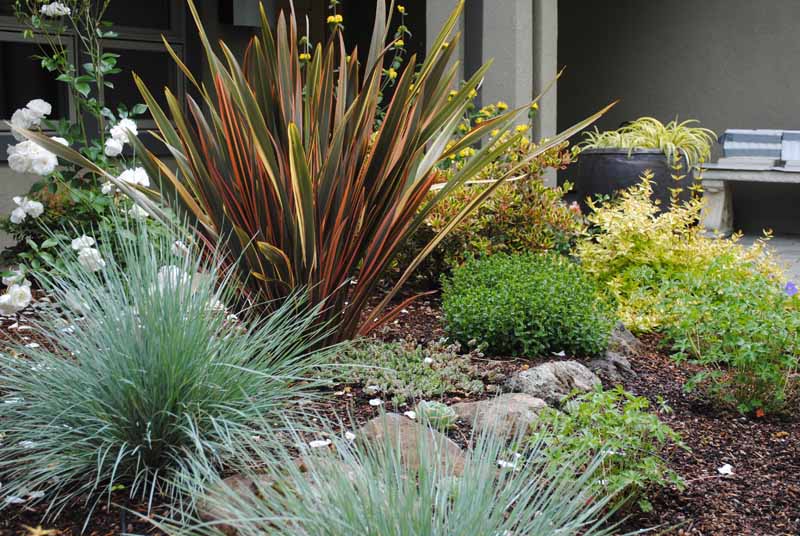 The steely blue blades of the helictotrichon sempervirens (Blue Oat Grass) repeat the shape of the nearby phormium ‘Maori Maiden’.
The steely blue blades of the helictotrichon sempervirens (Blue Oat Grass) repeat the shape of the nearby phormium ‘Maori Maiden’.
The drastically different sizes and colors, however, allow them to remain distinctly unique.
The cooling blue tones are a welcome site in this brightly colored garden.
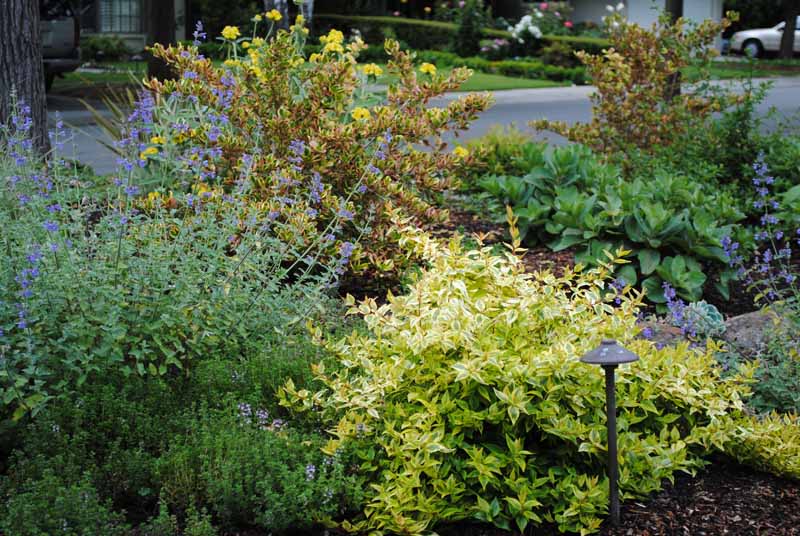
The bright leaves of the abelia ‘Kaleidescope’ are repeated with the foliage of coprosma ‘Pink Splendor,’ and the yellow flowers of the phlomis fruiticosa.
All are very low water, evergreen, and tough as nails in zone-9 gardens.
The gray-green foliage of nearby nepeta and sedum ‘Autumn Joy’ provides color contrast as well as fall-blooming flowers.
Even the pot on the front porch sports brightly colored agapanthus ‘Gold Strike’, repeating the foliage shapes and colors in the planting area behind.
The container, however, is a cooling shade of dark gray, blending in with the colors of the home and pathway.
I hope you’ve enjoyed the before-and-after transformation of this garden.
If you’d like to see more lawn-alternative gardens, please click here.
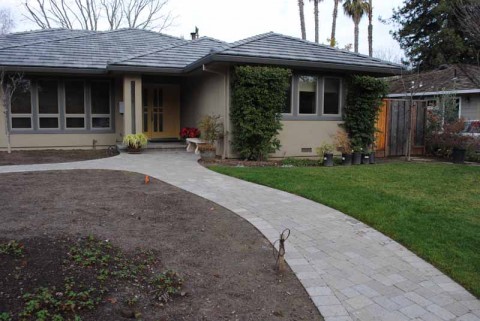
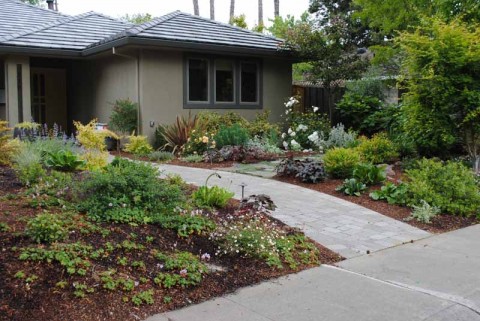
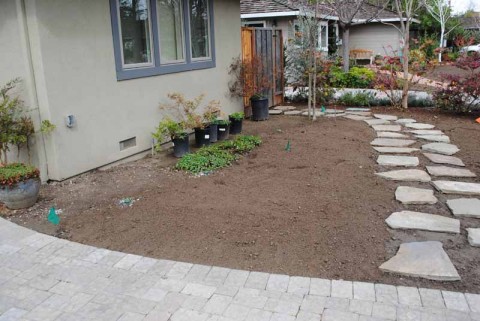
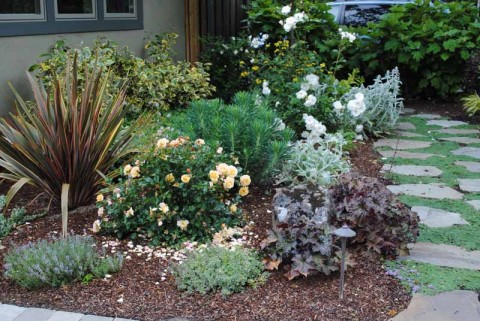
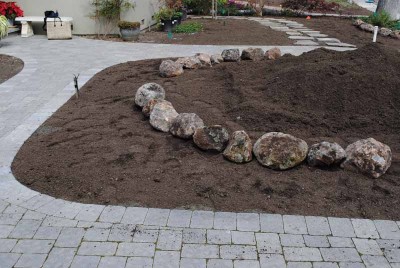








35 Comments
That looks beautiful and we just removed our lawn (1800 sq.ft) and are frozen about what to do. We’ve had estimates from 2 landscapers and are not confident about their ideas. We also have a shady area full of tree roots where we removed a 30 year old wheeping cherry tree and more roots from Japanese maples. On the other sunnier side we have large trees that produce a massive leaf drop in the fall. We want to incorporate rocks, plants and ground cover and that complicates everything! We need help!
Hi Rebecca,
I have your book “Refresh Your Garden Design” and (during the pandemic) saw two of your talks – one on “Refresh your Garden” with Discovery Bay Garden Club and “Sideyards” with Castro Valley Garden Club. Unfortunately, I had replaced my front lawn about 3 years before I saw you. Once my plants were established, I found I have the opposite problem from one-itis; I have too many of the same thing grouped together. I tried your “Fresh Eyes” approach and loved it but really hate to start taking out nice plants. Do you do consulting from photos? I would love some ideas.
Thanks for the post.
Very beautiful ideas.
I would suggest possibly incorporating some edible plants such as herbs to compliment
the ornamental species.
I agree – in fact, we did include rosemary, lemon and lime thyme throughout her garden. It’s rare that I design a garden without an herb or two!
Hi Rebecca:
Please show a photo of what you did around the FRONT of the Tree.
I love the idea of the semi circle of stones around the back of the Tree to raise the soil level for plants.
What did you do with the Tree (and its Roots) on the side near the Sidewalk? I have a City owned Tree, 60 years old with a well established root system, all around the Tree Trunk. There is 1.5-2 feet of plantable (?) soil in the front of it. The city owns the first 5 feet “in” from the Sidewalk. And the Tree (Camphor and everygreen) is their property.
Thanks, Anna
Anna – I’ll try and see if I have any photos of the very front of the tree and send them to your email address. There wasn’t much we could do as it butts up right next to the sidewalk with a wicked ‘drop’. Luckily (or unluckily) the roots make it so dense that the soil doesn’t erode when it rains!
Rebecca, I think you beautifully demonstrate how good a no-lawn, lawn can look. One thing worries me when I see landscaping shows inevitably in CA, where they remove the living lawn and put down fake grass instead. What do you think about that? Although it is easy wear, it doesn’t perform oxygen exchange. I just wonder.~~Dee
Hi Dee – you know, I’ve never had a client install an artificial turf lawn! I know a woman who installed a small section of it down the side of her house, primarily for her dogs to use as an area to go to the bathroom (weird, I know). This ‘lawn’ has never bleached out, and remains in pristine condition 7 years later – amazing! I think there hasn’t been enough long-term studies to determine the safety of this material as it begins to break down (which we all know it eventually will). I guess if I had a client who really really wanted a small area of it, I wouldn’t oppose too much, but if they wanted to install a massive area I’d try and talk them into considering other options. The high schools around here have installed it on their sports fields, and while it may look nice it gets super hot in the summer – to the point that you couldn’t walk on it barefoot without a little pain! That, and its really expensive turns most people off. Just my rambling thoughts!! 😉
very beautiful!! I just love a good before and after! are there any other blogs that you would recomend for good before and afters?
Thanks Lucy! Here’s Susan Morrison’s blog (she’s my co-author) who has some great before and afters you may be interested in….http://garden-chick.typepad.com/photos/before_and_after/index.html
i hope this beautiful garden and post emboldens others to rip out their water-hogging lawns! from what i have been seeing lately, lawn-free gardens almost always turn out so much more interesting and lower maintenance, too. love all your creative ideas!
Well, Janine, I know the neighbors across the street removed their front lawn last year, too! Let’s see if it catches on!
I love your designs. I specially like the idea of half circle rocks in the middle. Thanks for sharing.
Thanks for the compliment, Laura. I appreciate it!
Awesome work! Suddenly the space does’t look sad and forlorn anymore.
I agree, Katy, no longer sad and forlorn! Love the description…
A beautiful example of going lawnless and dividing the space with functional walkways. Like your other readers, I’m loving that half circle of stones set inside the bed. I’ll remember that solution!
Hi Pam – I’m so glad you like the half circle solution! I’ve used it for years and it always looks great (especially with succulents tucked in between, here and there…)
PS The half circle of stones is the coolest piece of info I have read for many moons! Thanks…
Love this Rebecca. Your designs are so comfortable and inviting. We got rid of our spit of grass right after we moved to our Denver home and now 4 neighbors have done the same. For me, gardening is so much more fun without grass… esp. in smaller spaces. Nepeta is now the fave plant in the hood! I love this carefree plant!!!
Sheila – I’m glad you feel this garden is comfortable and inviting as those are the two words that describe the homeowner to a tee! Hopefully her neighbors will catch on like yours did – lawns in this neighborhood are pretty small and useless (especially with the giant tree roots that they all have).
What a timely post. We have an ‘abandoned’ lawn in the front that we’ve let go, but our plan is to plant it with something more aesthetically pleasing. The only trouble is, the septic leach field runs right under it. As such, I’m going to have become more well versed with the roots of plants, than their tops! I think providing we avoid trees, and large deep-rooted shrubs, we should be ok. Keeping to more herbaceous perennials. I’d hate to make a costly mistake though. Have you had to contend with leach fields in lawnless front garden design Rebecca? I’d hate to just plant gravel, that seems so uninspired compared to these beautiful examples.
Curbstone – I don’t have any personal experience with leach fields but would imagine you definitely wouldn’t want to plant trees or deep-rooted giant shrubby plants. I’ve seen gorgeous gardens planted over them so I’m pretty sure your options are wide open if you avoid the obvious (like Willows – yikes!!) Have you posted this question on Facebook? If not, tag me and I’ll try and send it out as well…I’d be curious to see what everyone says!
Great ideas! Thanks for including the plant names. We are working on our grass but have a large section that will end up being mulched and converted to a no-lawn garden. This was inspiring.
Thanks Paige – when you’re finished I’d love to see photos of your garden!
Wow, the Cinderella of gardens! What a transformation. I love how the Blue Oat Grasses work with everything else. Also love that loose design of the side pathway with the thyme…does that grow well in shade? I would like to steal that idea!
Hi Robin – I have ‘Elfin’ thyme growing in dappled shade and it’s really, really happy. Typically thyme prefers full sun, but you might give it a try! I also have a pathway like this with baby tears growing (a little too rampantly at the moment) and its in the full shade. But those little ‘tears’ tend to fry once our summer hits and things warm up….
Gorgeous! love it.
Looking mighty sharp! Great job Rebecca, and I love the fluidity of the design. What type of grass was it you removed? Turf removal can be problematic in Austin, especially with the dreaded Bermuda.
What a great front garden transformation.
Can’t wait to see more.
ESP.
Thanks ESP! What kind of grass? Oh, a mixture of 25-year old fescues and weeds and whatnot. Removed it over a period of months then laid down a thick layer of mulch (no weedcloth, though). It’s been a little over a year now and no grass has come through (knock on wood). Glad you like the design!!
Wow Rebecca- this is gorgeous! That is one lucky homeowner!!!
Rebecca, this front yard is gorgeous. Thanks for sharing your design prowess–I love the half-circles created by the small boulders. Definitely going to remember that one! I bow.
You bow to ME Jenny? You’re making me blush…..thanks so much!! 🙂
GORGEOUS!!!!
Love love love … and the half-circle of stones! What a great solution; completely integrated! YAY!
XOXOXO
Thanks Ivette – I have lots more that are in their infancy. Can’t wait for the gardens to mature a bit so I can show them off, too! XXOO to you, TOO!